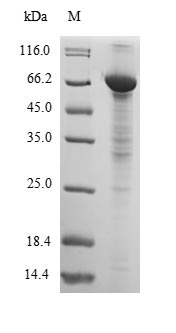Recombinant Dog Albumin (ALB) is produced in an E. coli expression system and includes the full length of the mature protein from amino acids 25 to 608. The product comes with an N-terminal 6xHis-tag that makes purification and detection more straightforward. SDS-PAGE analysis confirms purity levels exceeding 90%, which appears suitable for various experimental applications. Endotoxin levels are kept minimal to maintain compatibility with sensitive assays.
Albumin represents a major plasma protein that plays a critical role in maintaining osmotic pressure and transporting various endogenous and exogenous substances, including hormones and drugs. Its capacity to bind and transport a wide range of molecules likely makes it a key component in studies related to pharmacokinetics and drug delivery systems, as well as in developing diagnostic assays.
Potential Applications
Note: The applications listed below are based on what we know about this protein's biological functions, published research, and experience from experts in the field. However, we haven't fully tested all of these applications ourselves yet. We'd recommend running some preliminary tests first to make sure they work for your specific research goals.
Based on the provided information, the recombinant Dog Albumin is expressed in E. coli, a prokaryotic system. Albumin is a soluble protein that does not require complex post-translational modifications and is known to be successfully expressed in E. coli systems. The protein contains the full-length mature sequence (25-608aa), which includes all functional domains. While the probability of correct folding is reasonably high for this well-characterized protein, the presence of the N-terminal 6xHis tag could potentially influence folding, and the explicit lack of activity verification means the protein cannot be guaranteed to be correctly folded or bioactive without experimental validation. Albumin's bioactivity includes ligand-binding functions that require proper tertiary structure.
1. Protein-Protein Interaction Studies Using His-Tag Pull-Down Assays
The N-terminal 6xHis-tag enables immobilization for pull-down assays, but if the albumin is misfolded, it may not interact physiologically with binding partners (e.g., fatty acids, drugs), leading to non-specific interactions. The high purity (>90%) reduces background, but results should be interpreted cautiously until folding is validated through functional assays. If correctly folded, this application is valuable for studying species-specific interactions.
2. Comparative Biochemical Analysis with Human and Other Mammalian Albumins
This application is appropriate and should be prioritized. Comparative studies of stability, thermal denaturation, and electrophoretic mobility can provide insights into evolutionary adaptations. These techniques can also assess folding quality indirectly. The high purity supports reliable comparisons. Even if misfolded, these studies characterize the recombinant product's properties, though conclusions about species differences would be invalid.
3. Development and Validation of Canine-Specific Research Antibodies
This application is well-supported. The recombinant albumin can serve as an effective immunogen for antibody generation, as antibodies often recognize linear epitopes less dependent on native folding. The His-tag facilitates purification and screening. However, if misfolded, antibodies may not recognize conformational epitopes of native dog albumin in serum. Validation against natural dog serum albumin is recommended.
4. In Vitro Protein Folding and Stability Studies
This application is highly appropriate. The recombinant protein can be used directly to study folding mechanisms, stability parameters, and refolding kinetics. These experiments are valuable for characterizing the protein's behavior regardless of its initial folding state. The high purity and consistent production make it suitable for reproducible folding studies.
Final Recommendation & Action Plan
Given the high likelihood but unconfirmed status of correct folding, recommend first performing functional validation (e.g., ligand binding assays with known albumin ligands like fatty acids or dyes) and biophysical characterization (e.g., circular dichroism for secondary structure, size-exclusion chromatography for oligomeric state). If validated, the protein can be reliably used for all described applications; if misfolded, focus on antibody development and folding/stability studies, while avoiding interaction studies that require native conformation. For comparative studies, include properly folded albumins from other species as controls. The E. coli expression system is generally suitable for albumin production, but verification remains important for functional applications.






